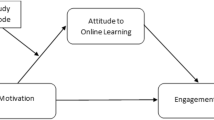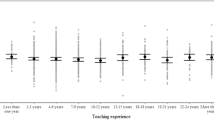Abstract
This paper aims to extend previous research into learning of tertiary biology, by exploring the learning approaches adopted by two groups of students studying the same first-year biology topic in either on-campus or off-campus “distance” modes. The research involved 302 participants, who responded to a topic-specific version of the Study Process Questionnaire, and in-depth interviews with 16 of these students. Several quantitative analytic techniques, including cluster analysis and Rasch differential item functioning analysis, showed that the younger, on-campus cohort made less use of deep approaches, and more use of surface approaches than the older, off-campus group. At a finer scale, clusters of students within these categories demonstrated different patterns of learning approach. Students’ descriptions of their learning approaches at interview provided richer complementary descriptions of the approach they took to their study in the topic, showing how deep and surface approaches were manifested in the study context. These findings are critically analysed in terms of recent literature questioning the applicability of learning approaches theory in mass education, and their implications for teaching and research in undergraduate biology.




Similar content being viewed by others
References
Adams, R. & Khoo, S.-T. (1993). Quest: the interactive test analysis system. Melbourne: The Australian Council for Educational Research.
Andrich, D. (1988). Rasch models for measurement. Newbury Park: Sage.
Bernard, R., Abrami, P., Lou, Y., Borokhovski, E., Wade, A., Wozney, L., et al. (2004). How does distance education compare with classroom instruction? A meta-analysis of the empirical literature. Review of Educational Research, 74(3), 379–439.
Biggs, J. (1987). Student approaches to learning and studying. Melbourne: Australian Council for Educational Research.
Biggs, J. (1993). From theory to practice: a cognitive systems approach. Higher Education Research and Development, 12(1), 73–85.
Biggs, J. (1999). What the student does: teaching for enhanced learning. Higher Education Research and Development, 18(1), 57–75.
Bond, T. G. & Fox, C. (2001). Applying the Rasch model: Fundamental measurement in the human sciences. Mahwah: Lawrence Erlbaum.
Crawford, K., Gordon, S., Nicholas, J., & Prosser, M. (1998a). Qualitatively different experiences of learning mathematics at university. Learning and Instruction, 8(5), 455–468.
Crawford, K., Gordon, S., Nicholas, J., & Prosser, M. (1998b). University mathematics students' conceptions of mathematics. Studies in Higher Education, 23, 87–94.
Cuthbert, P. (2005). The student learning process: learning styles or learning approaches? Teaching in Higher Education, 10(2), 235–249.
Dart, B. & Boulton-Lewis, G. (1998). Teaching and learning in higher education. Melbourne: Australian Council for Eductional Research.
Dobson. I. (2007). Sustaining science: university science in the twenty-first century. A study commissioned by the Australian council of deans of science: centre for population & urban research, Monash University & the educational policy institute Pty ltd.
Eizenberg, N. (1988). Approaches to learning anatomy: Developing a programme for preclinical medical students. In P. Ramsden (Ed.), Improving learning: New perspectives (pp. 178–198). London: Kogan Page.
Entwistle, N. & Ramsden, P. (1983). Understanding student learning. London: Croom Helm.
Entwistle, N. & Marton, F. (1984). Changing conceptions of learning and research. In F. Marton, D. Hounsell & N. Entwistle (Eds.), The experience of learning (pp. 211–228). Edinburgh: Scottish Academic.
Entwistle, N., Meyer, J., & Tait, H. (1991). Student failure: disintegrated patterns of study strategies and perceptions of the learning environment. Higher Education, 21, 246–261.
Gorard, S., See, B. H., Smith, E., & White, P. (2006). Teacher supply: The key issues. London: Continuum International.
Haggis, T. (2003). Constructing images of ourselves? A critical investigation into 'Approaches to Learning' research in higher education. British Educational Research Journal, 29(1), 89–104.
Harper, G. & Kember, D. (1986). Approaches to study of distance education students. British Journal of Educational Technology, 17(3), 212–222.
Harper, G. & Kember, D. (1989). Interpretation of factor analyses from the approaches to studying inventory. British Journal of Educational Psychology, 59, 66–74.
Harris, K.-L. & Farrell, K. (2007). The science shortfall: an analysis of the shortage of suitably qualified science teachers in Australian schools and the policy implications for universities. Journal of Higher Education Policy and Management, 29(2), 159–171.
Hattie, J. & Watkins, D. (1981). Australian and Filipino investigations of the internal structure of Biggs' new study process questionnaire. British Journal of Educational Psychology, 51, 241–244.
Hazel, E., Prosser, M., & Trigwell, K. (2002). Variation in learning orchestration in university biology courses. International Journal of Science Education, 24(7), 737–751.
Kember, D. (1990). The intention to both memorise and understand: another approach to learning? Higher Education, 31, 341–354.
Long, W. (2003). Dissonance detected by cluster analysis of responses to the approaches and study skills inventory for students. Studies in Higher Education, 28(1), 21–35.
Lyons, T. (2006). The puzzle of falling enrolments in physics and chemistry: putting some pieces together. International Journal of Science Education, 36, 285–311.
Meyer, J. H. F. (2000). The modelling of 'dissonant' study orchestration in higher education. European Journal of Psychology of Education, 15(1), 5–18.
Meyer, J. H. F. & Shanahan, M. (2003). Dissonant forms of 'memorising' and 'repetition'. Studies in Higher Education, 28(1), 5–20.
Miles, M. & Huberman, A. (1994). An expanded sourcebook: Qualitative data analysis (2nd ed.). Thousand Oaks: Sage.
Moin, L., Dorfield, J., & Schunn, C. (2005). Where can we find future K-12 science and math teachers? A search by academic year, discipline, and academic performance level. Science Education, 89(6), 980–1006.
Pallant, J. (2001). SPSS survival manual. A step by step guide to data analysis using SPSS. Chicago: Allen & Unwin.
Prosser, M. & Trigwell, K. (1999). Understanding learning and teaching: The experience in higher education. Buckingham: The Society for Research into Higher Education & Open University Press.
Prosser, M., Trigwell, K., Hazel, E., & Gallagher, P. (1994). Students' experiences of teaching and learning at the topic level. Research and Development in Higher Education, 16, 285–289.
Prosser, M., Walker, P., & Millar, R. (1995). Differences in students perceptions of learning physics. Physics Education, 31, 43–48.
Prosser, M., Hazel, E., Trigwell, K., & Lyons, F. (1996). Qualitative and quantitative indicators of students' understanding of physics concepts. Research and Development in Higher Education, 19, 670–675.
Quinn, F. (2006a). Engaging from a distance and on-campus with an introductory biology unit. Paper presented at the 9th International Pacific Rim First Year in Higher Education Conference - “Engaging Students”, 12–14 July 2006.
Quinn, F. (2006b). Learning approaches and outcomes in a first–year biology topic: A relational study involving distance and on–campus students. Unpublished PhD thesis, University of New England, Armidale.
Quinn, F., & Callingham, R. (2005). A Rasch measurement analysis of learning approaches: Internal and external students studying a first-year biology topic. Poster presentation. Paper presented at the Activity session, HERDSA conference, 3–6 July 2005.
Ramsden, P. (1984). The context of learning. In F. Marton, D. Hounsell & N. Entwistle (Eds.), The experience of learning (pp. 198–216). Edinburgh: Scottish Academic.
Ramsden, P. (1991). A performance indicator of teaching quality in higher education: the course experience questionnaire. Studies in Higher Education, 16(2), 129–150.
Ramsden, P. (1992). Learning to teach in higher education. London: Routledge.
Richardson, J. T. E. (1994a). Cultural specificity of approaches to studying in higher education: A literature survey. Higher Education, 27, 449–468.
Richardson, J. T. E. (1994b). Mature students in higher education: I. A literature survey on approaches to studying. Studies in Higher Education, 19(3), 309–325.
Richardson, J. T. E. (1994c). Using questionnaires to evaluate student learning: Some health warnings. In G. Gibbs (Ed.), Improving student learning—theory and practice (pp. 73–88). Oxford: Oxford Centre for Staff Development.
Richardson, J. T. E. (1998). Dispelling some myths about mature students in higher education: Study skills, approaches to studying, and intellectual ability. In P. Sutherland (Ed.), Adult learning: A reader (pp. 166–174). London: Kogan Page.
Richardson, J. T. E. (2000). Researching student learning: Approaches to studying in campus-based and distance education. Buckingham: The Society for Research into Higher Education and Open University Press.
Richardson, J. T. E. (2004). Methodological issues in questionnaire-based research on student learning in higher education. Educational Psychology Review, 16(4), 347–358.
Richardson, J. T. E., Morgan, A., & Woodley, A. (1999). Approaches to studying in distance education. Higher Education, 37, 23–55.
Rowntree, D. (1987). Assessing students: How shall we know them? London: Kogan Page.
SPSS. (2005). SPSS 12.0 Base System: SPSS Inc.
Tabachnick, B. & Fidell, L. (1996). Using multivariate statistics (3rd ed.). New York: Harper Collins.
Trigwell, K. & Prosser, M. (1997). Towards an understanding of individual acts of teaching and learning. Higher Education Research and Development, 16(2), 241–252.
Trigwell, K., Prosser, M., & Waterhouse, F. (1999). Relations between teachers approaches to teaching and students' approaches to learning. Higher Education, 37, 57–70.
Watkins, D. (1996). Learning theories and approaches to research: A cross-cultural perspective. In D. Watkins & J. Biggs (Eds.), The Chinese learner: Cultural, psychological and contextual influences (pp. 3–24). Hong Kong: Comparative Education Research Centre and The Australian Council for Educational Research.
Watkins, D. & Hattie, J. (1981). The learning processes of Australian university students: investigations of contextual and personological factors. British Journal of Educational Psychology, 51, 384–393.
Watters, D. & Watters, J. (2007). Approaches to learning by students in the biological sciences: implications for teaching. International Journal of Science Education, 29(1), 19–43.
Wright, B. & Masters, G. (1982). Rating scale analysis. Chicago: MESA.
Zeegers, P. (1999). Student learning in science: a longitudinal study using the Biggs SPQ. Paper presented at the HERDSA annual international conference 12–15 July 1999, Melbourne.
Zeegers, P. (2001). Approaches to learning in science: a longitudinal study. British Journal of Educational Psychology, 71, 115–132.
Acknowledgements
I gratefully acknowledge the comments and suggestions of John Pegg and Sarah Stein, and Rosemary Callingham for assistance with Rasch measurement modelling. My thanks are also extended to Michael Prosser for permission to use the topic-specific version of the SPQ and advice during the course of this study, and Erik Meyer for useful discussion on cluster analysis. Finally I am very grateful to the staff of the First Year Biology Teaching unit who facilitated the research, and to the students who generously gave their time to participate in this study.
Author information
Authors and Affiliations
Corresponding author
Rights and permissions
About this article
Cite this article
Quinn, F.C. Learning in First-Year Biology: Approaches of Distance and On-Campus Students. Res Sci Educ 41, 99–121 (2011). https://doi.org/10.1007/s11165-009-9148-7
Published:
Issue Date:
DOI: https://doi.org/10.1007/s11165-009-9148-7




